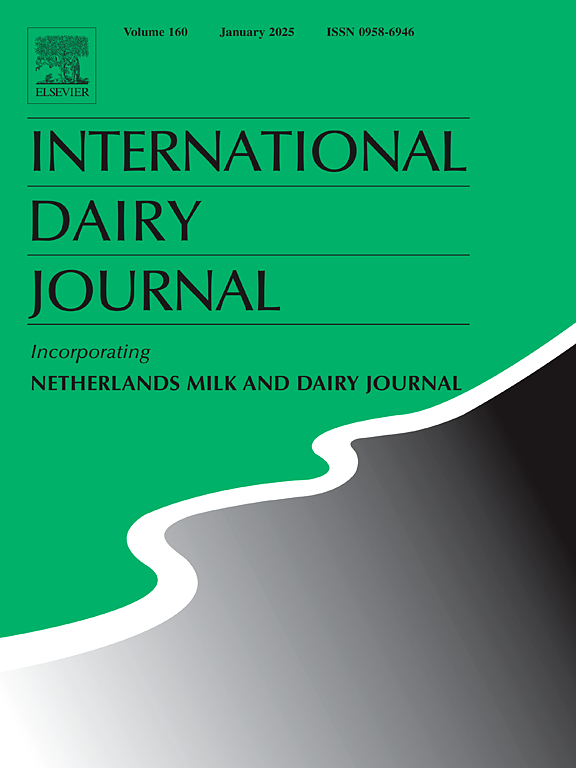酪蛋白糖宏肽胃肠道消化中靶向Nrf2抗氧化寡肽的鉴定
IF 3.1
3区 农林科学
Q2 FOOD SCIENCE & TECHNOLOGY
引用次数: 0
摘要
胃肠道不断暴露于各种有害因素,Nrf2在介导细胞防御这些因素,特别是氧化应激中起着至关重要的作用。糖宏肽(GMP)是一种生物活性肽,天然存在于牛奶中,在奶酪生产过程中也由κ-酪蛋白产生,具有促进健康的作用。本研究旨在从GMP胃肠道消化中鉴定靶向Nrf2的抗氧化寡肽(由2-10个氨基酸组成)。LC-MS/MS分析共鉴定出85个体外胃肠道消化肽,其中27个为寡肽。选择三个寡肽,即EINTVQVTS, SPPEINTVQ和KNQDKTEIPT,基于它们与Keap1蛋白的高相互作用评分,这是调节Nrf2激活的关键。基于细胞的研究证实了这些gmp衍生的寡肽激活Nrf2和下游抗氧化基因表达的能力。此外,动物研究表明,GMP通过Nrf2信号传导和肠道释放具有这三种寡肽的同源肽来增强体内抗氧化能力。我们的研究结果表明,GMP可能通过从胃肠道消化中释放靶向Nrf2的寡肽来增加肠道抗氧化能力并治疗氧化应激相关疾病。本文章由计算机程序翻译,如有差异,请以英文原文为准。
Identification of antioxidant oligopeptides targeting Nrf2 from gastrointestinal digestion of casein glycomacropeptide
The gastrointestinal tract is constantly exposed to various harmful factors, and Nrf2 plays a crucial role in mediating cellular defense against these factors, particularly oxidative stress. Glycomacropeptide (GMP), which naturally occurs in milk and is also produced from κ-casein during cheese production, is a bioactive peptide known for its health-promoting effects. This study aimed to identify antioxidant oligopeptides (composed of 2–10 amino acids) targeting Nrf2 from GMP gastrointestinal digestion. LC-MS/MS analysis identified a total of 85 peptides, including 27 oligopeptides, from GMP gastrointestinal digestion in vitro. Three oligopeptides, namely EINTVQVTS, SPPEINTVQ, and KNQDKTEIPT, were selected based on their high interaction scores with Keap1 protein, which is critical for regulating Nrf2 activation. Cell-based studies validated the ability of these GMP-derived oligopeptides to activate Nrf2 and downstream antioxidant gene expression. Furthermore, the animal study demonstrated in vivo antioxidant capacity enhancement by GMP via Nrf2 signaling and intestinal release of homologous peptides with these three oligopeptides. Our findings indicate that GMP could potentially increase intestinal antioxidant capacity and treat oxidative stress-related disorders by releasing oligopeptides targeting Nrf2 from gastrointestinal digestion.
求助全文
通过发布文献求助,成功后即可免费获取论文全文。
去求助
来源期刊

International Dairy Journal
工程技术-食品科技
CiteScore
6.50
自引率
9.70%
发文量
200
审稿时长
49 days
期刊介绍:
The International Dairy Journal publishes significant advancements in dairy science and technology in the form of research articles and critical reviews that are of relevance to the broader international dairy community. Within this scope, research on the science and technology of milk and dairy products and the nutritional and health aspects of dairy foods are included; the journal pays particular attention to applied research and its interface with the dairy industry.
The journal''s coverage includes the following, where directly applicable to dairy science and technology:
• Chemistry and physico-chemical properties of milk constituents
• Microbiology, food safety, enzymology, biotechnology
• Processing and engineering
• Emulsion science, food structure, and texture
• Raw material quality and effect on relevant products
• Flavour and off-flavour development
• Technological functionality and applications of dairy ingredients
• Sensory and consumer sciences
• Nutrition and substantiation of human health implications of milk components or dairy products
International Dairy Journal does not publish papers related to milk production, animal health and other aspects of on-farm milk production unless there is a clear relationship to dairy technology, human health or final product quality.
 求助内容:
求助内容: 应助结果提醒方式:
应助结果提醒方式:


